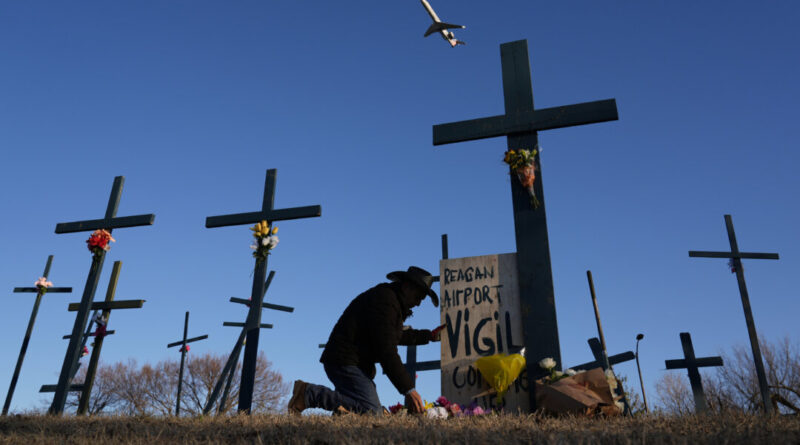Authorities Report Recovery and Identification of 55 Out of 67 Victims from Midair Collision
ARLINGTON, Va.—On Sunday, families of those lost in the deadliest U.S. air disaster since 2001 visited the site of the crash, while divers searched the submerged wreckage for additional remains after authorities announced they had recovered and identified 55 of the 67 victims.
Washington, D.C. Fire and EMS Chief John Donnelly expressed confidence that all victims would ultimately be located. He noted that divers are diligently searching for remains as teams prepare to retrieve wreckage from the icy waters of the Potomac River as soon as Monday morning, according to his statement at a recent press conference.
Col. Francis B. Pera of the Army Corps of Engineers mentioned that both divers and salvage teams are following strict protocols, emphasizing that operations would be paused if any remains are discovered. He stressed that the “dignified recovery” of the deceased is the top priority.
“Reuniting those lost in this tragic incident is what drives us forward,” Pera remarked. “Our teams have been committed to this mission since the onset, and we are determined to see it through.”
Donnelly added that divers are equipped with high-definition cameras, which provide real-time feeds monitored from support boats, enabling a collaborative effort with “four or five sets of eyes” inspecting the wreckage. He noted that, due to the cold conditions, one diver had to be treated for hypothermia at a hospital.
Parts of the two aircraft involved in the collision over the river Wednesday night—an American Airlines jet carrying 64 passengers and an Army Black Hawk helicopter with three crew members—will be transported on flatbed trucks to a hangar for further examination.
Family members were escorted by police buses to the Potomac Riverbank, where the aircraft rest after their mid-air collision. The American Airlines flight was attempting to land after departing from Wichita, Kansas, while the Black Hawk helicopter was conducting a training mission, with no survivors from either aircraft.
Federal investigators are currently piecing together the circumstances that led to the fatal incident.
Although the National Transportation Safety Board did not hold a press briefing on Sunday, they did share photographs of investigators examining wreckage from a small boat, including images of flight data recorders.
Transportation Secretary Sean Duffy stated he aims to allow investigators the necessary space for their work. However, he raised a variety of questions during morning news programs.
“What was occurring inside the control towers? Were they experiencing staffing shortages?… What was the positioning and altitude of the Black Hawk, and were its pilots wearing night vision goggles?” Duffy questioned on CNN.
Among the helicopter crew were Army Staff Sgt. Ryan Austin O’Hara, 28, of Lilburn, Georgia; Chief Warrant Officer 2 Andrew Loyd Eaves, 39, of Great Mills, Maryland; and Capt. Rebecca M. Lobach from Durham, North Carolina.
The passengers on the plane included figure skaters returning from the 2025 U.S. Figure Skating Championships and a group of hunters returning from a guided expedition.
The NTSB reported on Saturday that initial data revealed conflicting altitude readings for both the airliner and helicopter.
Investigators noted that approximately one second before the impact, the jet’s flight recorder indicated a change in its pitch. However, they have not confirmed whether this indicates an attempt by the pilots to evade the oncoming collision.
Data from the jet’s flight recorder indicated its altitude was around 325 feet (99 meters), give or take 25 feet (7.6 meters) at the time of the crash, whereas tower data reported the Black Hawk at 200 feet (61 meters), which is the maximum altitude authorized for helicopters in that area.
The cause of this discrepancy remains unclear.
Investigators expressed hope that they could clarify this inconsistency using data from the helicopter’s black box, along with an effort to refine the potentially unreliable tower data.
“This is a complex investigation,” stated Brice Banning, the lead investigator. “Many factors are involved.”
Banning indicated that the cockpit voice recorder captured sounds just prior to the crash.
“The crew had a vocal response,” Banning revealed, adding that the flight data recorder showed “the airplane beginning to elevate its pitch.” Sounds of the impact were recorded about a second later, followed by the conclusion of the recording.
Typically, full investigations can take over a year, although investigators are aiming to provide a preliminary report within a month.
NTSB member Todd Inman shared that he has dedicated several hours to meetings with victims’ families.
“Some have offered us hugs, while others express their anger and frustration,” Inman noted. “They are all in mourning and seeking answers, and we are committed to providing them with those answers.”
At times, over 300 responders have been engaged in recovery operations, officials mentioned, while two Navy barges were deployed for lifting heavier debris.
During an interview on Fox News Sunday, Duffy noted that the Federal Aviation Administration is examining staffing levels within the control tower at Reagan Airport.
Reports indicate that five controllers were on duty when the crash occurred, including a local controller, ground controller, assistant controller, supervising controller, and a trainee.
An FAA report acquired by The Associated Press indicated that one controller was managing both helicopter and plane traffic—responsibilities typically split between two individuals. The practice of combining these roles typically occurs around 9:30 p.m. when traffic diminishes, but the supervisor merged them earlier, a move the report described as “abnormal.”
“Staffing shortages in air traffic control have persisted for years,” Duffy remarked, assuring that President Donald Trump’s administration aims to rectify this issue with “intelligent, capable individuals in control towers managing airspace.”
Add to the national grief, an air ambulance crashed in Philadelphia on Friday, resulting in the fatalities of all six onboard, including a child returning home to Mexico after medical treatment, and at least one person on the ground.
On the same day, the FAA imposed significant restrictions on helicopter traffic around Reagan Airport, shortly following Trump’s social media comments about the helicopter’s unauthorized altitude.
The crash on Wednesday marked the most fatal aviation incident in the U.S. since November 12, 2001, when a jet crashed into a New York City neighborhood shortly after takeoff, killing all 260 passengers and five on the ground.
Experts emphasize that air travel remains exceedingly safe; however, the congested airspace around Reagan Airport poses challenges even for seasoned pilots.
By David R. Martin, Michael R. Sisak, and Claudia Lauer



